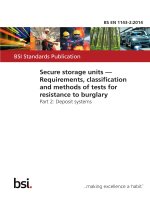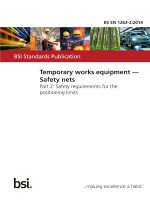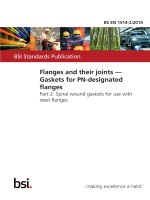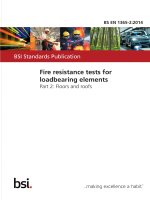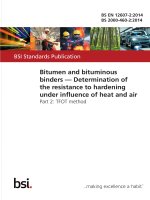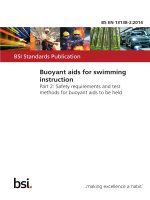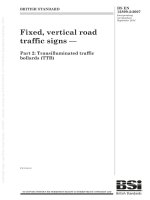Bsi bs en 62290 2 2014
Bạn đang xem bản rút gọn của tài liệu. Xem và tải ngay bản đầy đủ của tài liệu tại đây (1.37 MB, 76 trang )
BS EN 62290-2:2014
BSI Standards Publication
Railway applications — Urban
guided transport management
and command/control systems
Part 2: Functional requirements specification
BRITISH STANDARD
BS EN 62290-2:2014
National foreword
This British Standard is the UK implementation of EN 62290-2:2014. It
is identical to IEC 62290-2:2014. It supersedes BS EN 62290-2:2011
which is withdrawn.
The UK participation in its preparation was entrusted to Technical
Committee GEL/9, Railway Electrotechnical Applications.
A list of organizations represented on this committee can be obtained on
request to its secretary.
This publication does not purport to include all the necessary provisions of
a contract. Users are responsible for its correct application.
© The British Standards Institution 2014.
Published by BSI Standards Limited 2014
ISBN 978 0 580 80180 8
ICS 45.060.01
Compliance with a British Standard cannot confer immunity from
legal obligations.
This British Standard was published under the authority of the
Standards Policy and Strategy Committee on 30 September 2014.
Amendments/corrigenda issued since publication
Date
Text affected
BS EN 62290-2:2014
EUROPEAN STANDARD
EN 62290-2
NORME EUROPÉENNE
EUROPÄISCHE NORM
September 2014
ICS 45.060
Supersedes EN 62290-2:2011
English Version
Railway applications - Urban guided transport management and
command/control systems - Part 2: Functional requirements
specification
(IEC 62290-2:2014)
Applications ferroviaires - Systèmes de contrôle/commande
et de gestion des transports guidés urbains Partie 2: Spécification des exigences fonctionnelles
(CEI 62290-2:2014)
Bahnanwendungen - Betriebsleit- und
Zugsicherungssysteme für den städtischen
schienengebundenen Personennahverkehr Teil 2: Funktionale Anforderungsspezifikation
(IEC 62290-2:2014)
This European Standard was approved by CENELEC on 2014-08-14. CENELEC members are bound to comply with the CEN/CENELEC
Internal Regulations which stipulate the conditions for giving this European Standard the status of a national standard without any alteration.
Up-to-date lists and bibliographical references concerning such national standards may be obtained on application to the CEN-CENELEC
Management Centre or to any CENELEC member.
This European Standard exists in three official versions (English, French, German). A version in any other language made by translation
under the responsibility of a CENELEC member into its own language and notified to the CEN-CENELEC Management Centre has the
same status as the official versions.
CENELEC members are the national electrotechnical committees of Austria, Belgium, Bulgaria, Croatia, Cyprus, the Czech Republic,
Denmark, Estonia, Finland, Former Yugoslav Republic of Macedonia, France, Germany, Greece, Hungary, Iceland, Ireland, Italy, Latvia,
Lithuania, Luxembourg, Malta, the Netherlands, Norway, Poland, Portugal, Romania, Slovakia, Slovenia, Spain, Sweden, Switzerland,
Turkey and the United Kingdom.
European Committee for Electrotechnical Standardization
Comité Européen de Normalisation Electrotechnique
Europäisches Komitee für Elektrotechnische Normung
CEN-CENELEC Management Centre: Avenue Marnix 17, B-1000 Brussels
© 2014 CENELEC All rights of exploitation in any form and by any means reserved worldwide for CENELEC Members.
Ref. No. EN 62290-2:2014 E
BS EN 62290-2:2014
EN 62290-2:2014
-2-
Foreword
The text of document 9/1914/FDIS, future edition 2 of IEC 62290-2, prepared by IEC/TC 9 "Electrical
equipment and systems for railways" was submitted to the IEC-CENELEC parallel vote and approved
by CENELEC as EN 62290-2:2014.
The following dates are fixed:
–
latest date by which the document has to be implemented at
national level by publication of an identical national
standard or by endorsement
(dop)
2015-05-14
–
latest date by which the national standards conflicting with
the document have to be withdrawn
(dow)
2017-08-14
This document supersedes EN 62290-2:2011.
Attention is drawn to the possibility that some of the elements of this document may be the subject of
patent rights. CENELEC [and/or CEN] shall not be held responsible for identifying any or all such
patent rights.
Endorsement notice
The text of the International Standard IEC 62290-2:2014 was approved by CENELEC as a European
Standard without any modification.
-3-
BS EN 62290-2:2014
EN 62290-2:2014
Annex ZA
(normative)
Normative references to international publications
with their corresponding European publications
The following documents, in whole or in part, are normatively referenced in this document and are
indispensable for its application. For dated references, only the edition cited applies. For undated
references, the latest edition of the referenced document (including any amendments) applies.
NOTE 1
When an International Publication has been modified by common modifications, indicated by (mod),
the relevant EN/HD applies.
NOTE 2
Up-to-date information on the latest versions of the European Standards listed in this annex is
available here: www.cenelec.eu.
Publication
Year
Title
EN/HD
Year
IEC 62290-1
-
Railway applications - Urban guided
transport management and
command/control systems Part 1: System principles and fundamental
concepts
EN 62290-1
-
–2–
BS EN 62290-2:2014
IEC 62290-2:2014 © IEC 2014
CONTENTS
INTRODUCTION ..................................................................................................................... 6
1
Scope .............................................................................................................................. 9
2
Normative references ...................................................................................................... 9
3
Terms, definitions and abbreviations ............................................................................... 9
4
Operational concept ........................................................................................................ 9
4.1
Organisation of operation for urban guided transport .............................................. 9
4.2
Basic operational principles .................................................................................. 11
4.3
Principles to ensure safe route .............................................................................. 11
4.4
Principles to ensure safe separation of trains ........................................................ 12
4.5
Principles to ensure safe speed ............................................................................ 12
4.6
Degraded modes of train operation ....................................................................... 13
5
Functions for train operation .......................................................................................... 13
5.1
Ensure safe movement of trains ............................................................................ 14
5.1.1
Ensure safe route .......................................................................................... 14
5.1.2
Ensure safe separation of trains .................................................................... 17
5.1.3
Determine permitted speed ............................................................................ 20
5.1.4
Authorize train movement .............................................................................. 22
5.1.5
Supervise train movement ............................................................................. 25
5.1.6
Provide interface with external interlocking .................................................... 29
5.2
Drive train ............................................................................................................. 29
5.2.1
Determine operating speed profile ................................................................. 30
5.2.2
Control train movement in accordance with train operating speed profile ....... 31
5.2.3
Stop train in station ....................................................................................... 31
5.3
Supervise guideway .............................................................................................. 33
5.3.1
Prevent collision with obstacles ..................................................................... 33
5.3.2
Prevent collisions with persons on tracks ....................................................... 34
5.3.3
Protect staff on track by work zone ................................................................ 38
5.4
Supervise passenger transfer ............................................................................... 39
5.4.1
Control train and platform doors .................................................................... 39
5.4.2
Prevent injuries to persons between cars or between platform and train ........ 42
5.4.3
Ensure starting conditions ............................................................................. 42
5.5
Operate a train ...................................................................................................... 44
5.5.1
Put in or take out of operation ........................................................................ 44
5.5.2
Manage driving modes ................................................................................... 45
5.5.3
Manage movement of trains between two operational stops ........................... 46
5.5.4
Manage depots and stabling areas ................................................................ 46
5.5.5
Manage UGTMS transfer tracks ..................................................................... 47
5.5.6
Restrict train entry to station .......................................................................... 47
5.5.7
Change the travel direction ............................................................................ 47
5.5.8
Couple and split a train .................................................................................. 48
5.5.9
Supervise the status of the train .................................................................... 49
5.5.10
Manage traction power supply on train........................................................... 51
5.6
Ensure detection and management of emergency situations ................................. 52
5.6.1
React to detected fire/smoke ......................................................................... 52
5.6.2
React to detected derailment ......................................................................... 53
BS EN 62290-2:2014
IEC 62290-2:2014 © IEC 2014
6
5.6.3
5.6.4
5.6.5
5.6.6
Functions
–3–
React to detected or suspected broken rail .................................................... 53
Manage passenger requests .......................................................................... 54
React to loss of train integrity ........................................................................ 55
Supervise closed and locked status of train doors ......................................... 56
for operation management and supervision ................................................... 57
6.1
Manage the daily timetable ................................................................................... 57
6.1.1
Import timetables ........................................................................................... 57
6.1.2
Select the timetable ....................................................................................... 57
6.1.3
Modify the operational timetable .................................................................... 58
6.2
Manage the train service ....................................................................................... 58
6.2.1
Manage train missions ................................................................................... 58
6.2.2
Set routes automatically ................................................................................ 60
6.2.3
Regulate trains .............................................................................................. 61
6.2.4
Ensure connecting services ........................................................................... 61
6.2.5
Manage operational disturbances .................................................................. 62
6.2.6
Dispatch trains .............................................................................................. 62
6.3
Supervise train operations .................................................................................... 63
6.3.1
Supervise train tracking ................................................................................. 63
6.3.2
Supervise trains and wayside equipment ....................................................... 64
6.3.3
Supervise passengers ................................................................................... 65
6.4
Control traction power ........................................................................................... 66
6.4.1
Monitor traction power supply ........................................................................ 66
6.4.2
Command traction power supply .................................................................... 66
6.4.3
Control regenerative braking .......................................................................... 66
6.5
Manage the interface with the HMI ........................................................................ 66
6.5.1
Manage the interface with operations control HMI .......................................... 67
6.5.2
Manage the interface with the train HMI ......................................................... 67
6.6
Provide interface with the communication system for passengers and staff ........... 67
6.7
Provide interface with the passengers information system .................................... 68
6.8
Provide interface with passenger surveillance system ........................................... 68
6.9
Support maintenance ............................................................................................ 68
6.10 Manage rolling stock and staff resources .............................................................. 69
6.10.1
Assign rolling stock to operation needs .......................................................... 69
6.10.2
Assign or reassign train staff ......................................................................... 69
Bibliography .......................................................................................................................... 71
Figure 1 – The three-step process followed by the UGTMS standard ...................................... 7
Figure 2 – Organisation of operation ..................................................................................... 10
Figure 3 – Train protection profile and speed supervision ..................................................... 13
Figure 4 – Specification of a safe route ................................................................................. 14
–6–
BS EN 62290-2:2014
IEC 62290-2:2014 © IEC 2014
INTRODUCTION
IEC 62290 standard series specifies the functional, system and interface requirements for the
command, control, and management systems intended to be used on urban, guided
passenger transport lines and networks. This series does not apply to lines that are operated
under specific railway regulations, unless otherwise specified by the authority having
jurisdiction.
These systems are designated here as Urban Guided Transport Management and
Command/Control Systems (UGTMS). UGTMS cover a wide range of operations needs from
non-automated (GOA1) to unattended (GOA4) operation. A line may be equipped with
UGTMS on its full length or only partly equipped.
This series does not specifically address security issues. However, aspects of safety
requirements may apply to ensuring security within the urban guided transit system.
The main objective of this series is to achieve interoperability, interchangeability and
compatibility.
This series is a recommendation for those transport authorities wishing to introduce
interoperable, interchangeable and compatible equipment.
It is the responsibility of the transport authority concerned in accordance with the authority
having jurisdiction to decide on how to apply this series and to take into account their
particular needs.
IEC 62290 series is also intended to support applications for upgrading existing signalling and
command control systems. In this case, interchangeability and compatibility could be ensured
only for the additional UGTMS equipment. Checking the possibility for upgrading existing
equipment and the level of interoperability is the responsibility of the transport authority
concerned.
Application of the series should take into account the differences between the various
networks operated in different nations. Those differences include operational and regulatory
requirements as well as different safety cultures.
This series defines a catalogue of UGTMS requirements split into mandatory and optional
functions. The functions used are based on the given grade of automation. By fulfilling the
requirements, a supplier can create one or more generic applications including all mandatory
functions and all or a subset of optional functions. A generic application will achieve
interoperability within the defined specific application conditions. Customising a generic
application will create a specific application taking into account of local conditions such as
track layout and headway requirements. It is the choice of supplier and transport authority to
add additional functions to a generic or specific application. These additional functions are not
described in this series.
According to IEC 62278, it is the responsibility of the transport authority, in agreement with
the authority having jurisdiction, to decide, taking into account their risk acceptance principles
to conduct specific hazard and risk analysis for each specific application. The safety levels for
the functions of each specific application have to be determined by a specific risk analysis.
Terms like "safety related command", "safety conditions", "safe station departure" are
mentioned without having performed any hazard analysis.
Standard series IEC 62290 is intended to consist of four parts:
•
Part 1 “System principles and fundamental concepts” provides an introduction to the
standard and deals with the main concepts, the system definition, the principles and
BS EN 62290-2:2014
IEC 62290-2:2014 © IEC 2014
–7–
the basic functions of UGTMS
Command/Control Systems).
(Urban
Guided
Transport
Management
and
The three other parts correspond to the three steps (see Figure 1) required in the process of
specifying UGTMS and are to be used accordingly.
•
Part 2 “Functional requirements specification” specifies the functional requirements
associated to the basic functions provided by Part 1, within the system boundaries and
interfaces as defined in Figure 3 of Part 1.
The FRS (Functional Requirements Specification) identifies and defines the functions
that are necessary to operate an urban guided transport system. Two types of
functions are distinguished for a given grade of automation: mandatory functions (e.g.
train detection) and optional functions (e.g. interfaces to passenger information and
passenger surveillance systems). Requirements of functions have the same allocation,
unless they are marked otherwise.
•
Part 3 (under consideration) “System requirements specifications” deals with the
architecture of the system and the allocation of the requirements and functions
identified in Part 2 to architecture constituents.
The SRS (System Requirement Specification) specifies the architecture of a UGTMS
system, with mandatory and optional constituents.
•
Part 4 (under consideration) “Interface specifications” deals with the definition of the
interfaces, as well as the data exchanged by them (FIS and FFFIS), for the
interoperable and interchangeable constituents identified in Part 3.
For interfaces between UGTMS constituents, the logical interface or FIS (Functional
Interface Specification) and/or the physical and logical interface or FFFIS (Form Fit
Functional Interface Specification) will be considered.
NOTE The specific structures of Part 3 and Part 4 will be established following completion of Part 2 to
accommodate optional and mandatory constituents, and to reflect local conditions. In principle, only one FIS or/and
FFFIS will be defined for the same interface. However, when justified in some cases, several FISs or several
FFFISs will be defined for the same interface.
Functional
requirements
(FRS)
System requirements
(SRS)
Interface requirements
(FIS or/and FFFIS)
IEC 891/11
Figure 1 – The three-step process followed by the UGTMS standard
Requirements are those necessary to fulfil all operational needs for safe and orderly operation
requested by transport authorities without regard to technical solutions.
–8–
BS EN 62290-2:2014
IEC 62290-2:2014 © IEC 2014
The chosen level of detail in describing requirements enables customers as well as authorities
having jurisdiction to be assured that generic applications delivered by different suppliers will
cover at least the same functionality as specified in this part of IEC 62290.
Requirements which are established by this series are indicated clearly with a requirement
identification number related to the function to be covered.
BS EN 62290-2:2014
IEC 62290-2:2014 © IEC 2014
–9–
RAILWAY APPLICATIONS –
URBAN GUIDED TRANSPORT MANAGEMENT
AND COMMAND/CONTROL SYSTEMS –
Part 2: Functional requirements specification
1
Scope
This part of IEC 62290 specifies the functional requirements of UGTMSs (Urban Guided
Transport Management and Command/Control Systems) for use in urban guided passenger
transport lines and networks. This part of IEC 62290 is applicable for new lines or for
upgrading existing signalling and command control systems.
This part of IEC 62290 is applicable to applications using:
•
continuous data transmission
•
continuous supervision of train movements by train protection profile
•
localisation of trains by external wayside equipment or reporting trains.
This standard is not applicable to existing command and control systems or projects in
progress prior to the effective date of this standard.
In this Part 2 of the standard, the functional requirements set the framework to which detailed
functions should be added to define any generic or specific application.
Because of that, although this part of the standard is applicable as a basis to define SRS, FIS
and FFFIS, elements may be added for a generic or specific application.
2
Normative references
The following documents, in whole or in part, are normatively referenced in this document and
are indispensable for its application. For dated references, only the edition cited applies. For
undated references, the latest edition of the referenced document (including any
amendments) applies.
IEC 62290-1, Railway applications – Urban guided transport management
command/control systems – Part 1: System principles and fundamental concepts
3
and
Terms, definitions and abbreviations
For the purposes of this document, the terms, definitions and abbreviations given in
IEC 62290-1 apply.
4
4.1
Operational concept
Organisation of operation for urban guided transport
The organisation of operation for public transport is structured generally into the following
tasks and carried out by using infrastructure (guideway and its elements) and trains (see
Figure 2):
BS EN 62290-2:2014
IEC 62290-2:2014 â IEC 2014
10
ã
planning operation (Offices for planning operation including timetable, train- and staff
resources), which is out of the scope of this standard,
•
operations management and supervision (Operations Control Centre) as described in
Clause 6,
•
execute train operations, as described in Clause 5,
•
maintenance for all facilities and equipment of the transport system, especially
infrastructure, trains, UGTMS equipment. Maintenance is out of the scope of this
standard but UGTMS supports maintenance as described in 6.9.
Operations planning
Timetable
Duty roster
Train service table
Operations
statistics
Office
Manage train
services
Supervise
operations
Operations management
and supervision
Operations control centre
Maintenance
Trains
Infrastructure
Workshops
Train operation
Ensure
safe
movement
of trains
Drive
trains
Operate
trains
Supervise
guideway
Supervise
passenger
transfer
Detect and
manage
emergency
situations
IEC 892/11
Figure 2 – Organisation of operation
This operations organisation hierarchy provides an overview of UGTMS functions of this
functional requirements specification. It is also a first approach for a system hierarchy to be
described in the System Requirement Specification (SRS). Train operations are enabled by
command-control equipment situated both at the wayside and onboard, which interfaces to
the OCC equipment. Operation management and supervision is carried out from the OCC
which provides also the interface to operations control HMI to operate and display all
functions required by UGTMS.
The task of operations planning contains all necessary measures to prepare operation.
Operation planning has to provide the operation management and supervision level with all
necessary information to execute train operation and will be provided with information from
BS EN 62290-2:2014
IEC 62290-2:2014 © IEC 2014
– 11 –
management and supervision level to enable adjustment of the planning process for
operational needs.
Operations management and supervision include all measures which are necessary to ensure
operations in normal, perturbed and failure situations.
The functions to be realised on this level are described in Clause 6.
4.2
Basic operational principles
UGTMS can be applied to a wide range of urban guided transport systems and the specific
UGTMS operational requirements for a given application will depend on the required grade of
automation. The following basic operational principles will however apply for all UGTMS
applications.
UGTMS will have precise knowledge of the limits of UGTMS territory which can include both
mainline and yard tracks.
UGTMS will include the capability to perform verification checks of the UGTMS onboard
equipment prior to entering UGTMS territory. The checks should be performed sufficiently in
advance of entry into UGTMS territory to verify the proper operation of the UGTMS onboard
equipment, including any UGTMS wayside equipment dependencies.
Under normal circumstances, it should not be necessary for a train to come to a stop when
entering or exiting UGTMS territory, unless required for other safety or operational reasons.
UGTMS-equipped trains can include passenger trains, non-passenger trains and maintenance
trains and different functional requirements may apply to the different types of train. For
example, non-passenger trains and maintenance trains will normally not be required to stop at
passenger stations on the mainline.
UGTMS-equipped trains will be capable of operating in various driving modes, depending on
the grade of automation and on the operational status of the UGTMS onboard and/or wayside
equipment.
UGTMS will ensure a safe route, safe train separation, and the safe speed of all UGTMSequipped trains operating in UGTMS territory. Trains can be operated manually by a train
driver, or automatically by UGTMS depending on the grade of automation. When operating
automatically, some functions (such as door operation) may continue to be the responsibility
of the train staff.
Trains not equipped with UGTMS onboard equipment, and/or trains with inoperative UGTMS
onboard equipment, that are operating in UGTMS territory will operate under the protection of
either a separate fall-back wayside signal system or operating procedures, or a combination
of both, as specified by the transport authority. (See also 4.6 below).
Commands from staff shall be provided via the interface with the operations control HMI.
Systems are run either with or without a timetable, for example by using headway regulation
only.
4.3
Principles to ensure safe route
The operational purpose of setting routes is to allow trains to travel to different destinations in
the network.
UGTMS permits trains to be manually or automatically routed between any defined origin and
destination in accordance with the train service requirements for the line, predefined routing
– 12 –
BS EN 62290-2:2014
IEC 62290-2:2014 © IEC 2014
rules, and any UGTMS user-directed service strategy. Where applicable to the specific track
configuration, automatic routing will support the proper merging and diverging of trains at
junctions, the turnback of trains, the movement of trains from/to yards and train storage
areas, and the rerouting of trains in response to service disruptions and/or planned outages.
UGTMS will ensure a safe route for all UGTMS trains in all grades of automation.
To prevent train collisions and derailments, train movement will not be authorized until the
route is set and locked. The route will be locked prior to the train entering the route and route
locking will be maintained while the train is within the route. Routes will be released by
manual commands or by movement of trains.
Ensuring a safe route is either a UGTMS function or an external function, in the latter case
appropriate interface shall be provided.
4.4
Principles to ensure safe separation of trains
The required design and operating headways for the line will be as specified by the transport
authority. The design headway for a line involves many factors that are outside of UGTMS
(e.g. track alignment, gradients, track speed limits, train acceleration and braking rates,
station dwell times, terminal track configurations, driver reaction times, etc.). These factors
shall be specified by the transport authority. UGTMS factors contributing to achievable
headways include accuracy of train location and train speed determination, resolution of
movement authority limits for a given train, frequency at which location reports and movement
authorities are updated, data communication delays, and UGTMS equipment reaction times
for both UGTMS wayside and UGTMS onboard equipment.
UGTMS will provide safe train separation assurance in all grades of automation based on the
principle of an instantaneous stop of a preceding train. Safe train separation may be achieved
using either fixed block or moving block principles.
To ensure safe train separation, UGTMS establishes an absolute movement authority limit for
each train based on the determined location of the train ahead. This absolute movement
authority limit represents the limit of movement protection for a following train, with
appropriate consideration of the location margin inaccuracy of the preceding train (including
any rollback tolerance).
4.5
Principles to ensure safe speed
UGTMS will provide overspeed protection in all grades of automation to ensure that the train's
actual speed will not exceed its safe speed. The safe speed will be derived with consideration
of both permanent and temporary speed limits within the train's movement authority as well as
any permanent or temporary speed restrictions applicable to the train.
UGTMS ensures that a train does not travel beyond the train protection profile by supervising
train movement along the authorized route to a defined target point (see Figure 3). The
distance between the target point and movement authority limit is a variable safety distance,
as determined by the safe braking model, to ensure that the limit of movement protection will
not be exceeded. The safe braking model includes consideration of factors such as location
margin inaccuracy of following train, train length, allowable overspeed permitted by the
UGTMS system, maximum speed measurement error, UGTMS reaction times and latencies,
maximum train acceleration rate possible at the time an overspeed condition is detected by
UGTMS, worst-case reaction times to disable the propulsion system and apply the emergency
brakes following detection of an overspeed condition, and emergency brake rate, etc.
BS EN 62290-2:2014
IEC 62290-2:2014 © IEC 2014
– 13 –
Speed restriction(s) within train’s intended route
Movement authority limit
Train protection
profile
Authorized speed
Train location
Target point
Safety margin
IEC 893/11
Figure 3 – Train protection profile and speed supervision
According to the safe braking model, any violation of the train protection profile will not result
in the train being beyond the movement authority limit.
4.6
Degraded modes of train operation
It is a basic operational principle to continue to move trains with a level of safety potentially
degraded in the event of UGTMS equipment failures, possibly at reduced operating speeds
and/or increased operating headways when compared to normal train operations. As a
consequence, UGTMS will support degraded modes of operation in the event of failure, and
will continue to provide train protection with minimum reliance on adherence to operating
procedures. This will be achieved through functional elements of UGTMS itself, through a
separate non-UGTMS fall-back wayside signal system (if specified by the transport authority),
or through strict adherence to operating procedures, or through a combination of any or all of
the above.
Degraded modes of train operation should take advantage of the functional capabilities of
UGTMS in order to eliminate hazards to passengers and staff while continuing to provide
passenger train service. Specifically, degraded modes of train operations in UGTMS territory
should address those UGTMS equipment failures that affect all trains operating within a
particular area of control or a particular train operating within any area of control.
For all functions of UGTMS a non-communicating train or a train with inoperative onboard
equipment shall be handled in the same way as a non-equipped train.
5
Functions for train operation
This clause contains all functions which are necessary for train operation to be provided by
UGTMS.
– 14 –
5.1
BS EN 62290-2:2014
IEC 62290-2:2014 © IEC 2014
Ensure safe movement of trains
Ensuring safe movement of trains is achieved by:
•
Ensuring a safe route for each train; this can be done internally (addressed in 5.1.1) or
externally with an interface with external interlocking (addressed in 5.1.6)
•
Determining the location of all trains and limits of safe train separation (addressed in
5.1.2)
•
Determining the actual train speed (addressed in 5.1.5.1) and the maximum allowable
train speeds (addressed in 5.1.3)
•
Authorizing train movement in accordance with a movement authority limit and train
protection profile (addressed in 5.1.4)
•
Supervising train movement in accordance with this movement authority limit and train
protection profile (addressed in 5.1.5)
5.1.1
Ensure safe route
Mandatory: all GOAs if "Ensure safe route" functions are provided by UGTMS
This subclause contains all functions necessary to command, control and check route
elements, set and release routes.
In order to prevent train collision and derailment, a route is to be considered as safe, if all
requested elements of the guideway are locked in the required position to prevent concurrent
use by another train.
A safe route consists of one or more related route elements which are used for:
•
area between route origin (RO) to route destination (RD),
•
flank protection purposes, and
•
the overlap (OVL).
FPA
RD
RO
OVL
RO
Combined route
FPA
RD
OVL
IEC 894/11
Key
RO
route origin
RD
route destination
OVL
overlap
FPA
flank protection area
Figure 4 – Specification of a safe route
The logical element route is seen from UGTMS as a combination of route elements with
specified conditions. A route shall be described taking into account the following conditions:
•
route origin as a location, where authorization to enter the route shall be given,
BS EN 62290-2:2014
IEC 62290-2:2014 â IEC 2014
15
ã
route elements between route origin and route destination, which are to be traversed
by the train,
•
route elements of overlap, which are reserved for safety reasons in case of deviations
from an authorized train movement,
•
route elements in the flank protection area, which avoid or detect unauthorized flank
movement.
An overlap can be replaced by a following safe route building a combined route (see
Figure 4).
The description of each route for a specific application is usually provided in a “route
interlocking table” as an input to UGTMS. The “route interlocking table” specifies also the site
specific required conditions for each route element in the defined route as a demand for
customising the generic application for site-specific needs.
5.1.1.1
5.1.1.1.1
Set and protect route
Set route
Mandatory: all GOAs
This function is intended to set a route by command provided via the operations control HMI
or by the function set routes automatically.
#REQ_5.1.1.1.1-1#
UGTMS shall set a route by command provided via the interface with the operations control
HMI or by the function set routes automatically.
#REQ_5.1.1.1.1-2#
For the route to be set, UGTMS shall determine the route elements required based on the
route origin and destination, including elements required for flank protection, and for overlap.
#REQ_5.1.1.1.1-3#
For the route to be set, the availability of all determined route elements shall be checked.
#REQ_5.1.1.1.1-4#
Availability shall be given if a route element is not used for another route or blocked against
route setting.
#REQ_5.1.1.1.1-5#
The reserved status of a route element shall be provided to the interface with the operations
control HMI to be displayed. (O)
#REQ-5.1.1.1.1-6#
UGTMS shall move a reserved movable route element to the desired position if it is not
already in that position, not occupied by a train and not blocked against moving.
#REQ_5.1.1.1.1-7#
– 16 –
BS EN 62290-2:2014
IEC 62290-2:2014 © IEC 2014
If a movable route element does not reach the desired position in a predefined time a failure
message shall be provided to the interface with the operations control HMI to be displayed.
(O)
#REQ_5.1.1.1.1-8#
UGTMS shall lock all route elements in a route to be set if they are confirmed in the required
position.
#REQ_5.1.1.1.1-9#
UGTMS shall command movable route elements (e.g. a point) from one position to the other
by command provided via the interface with the operations control HMI.
#REQ_5.1.1.1.1-10#
UGTMS shall block a movable route element against switching by command provided via the
interface with the operations control HMI.
5.1.1.1.2
Supervise route
Mandatory: all GOAs
This function is intended to supervise that all conditions for the route are still in place.
#REQ_5.1.1.1.2-1#
UGTMS shall supervise that determined route elements are confirmed in the required position
and locked.
#REQ_5.1.1.1.2-2#
The supervision status of a route shall be provided to the interface with the operations control
HMI to be displayed. (O)
#REQ_5.1.1.1.2-3#
A route can be supervised with missing conditions if a specified subset of conditions is
present. (O)
#REQ_5.1.1.1.2-4#
The entrance to a route shall be prohibited by a safety related command provided via the
interface with the operations control HMI. (O)
5.1.1.1.3
Lock route
Mandatory: all GOAs
This function is intended to lock the route:
•
for an approaching train for which the movement authority allows entry into the route,
•
or if this train is within the route.
#REQ_5.1.1.1.3-1#
BS EN 62290-2:2014
IEC 62290-2:2014 © IEC 2014
– 17 –
A train approach area shall be determined in front of a route origin for which movement
authority has been given.
The approach area shall cover an area which is longer than the operational braking distance.
#REQ_5.1.1.1.3-2#
The route shall be locked by approach if a train is in the approach area and a movement
authority has been given to a train.
#REQ_5.1.1.1.3-3#
The route elements in front of the train shall be maintained locked as soon as the train has
entered the set route.
5.1.1.2
Release route
Mandatory: all GOAs
This function is intended to release a route and its elements.
#REQ_5.1.1.2-1#
UGTMS shall release a route element by element, group of elements, or as a whole by a train
traversing the elements in the sequence corresponding to the authorized direction.
#REQ_5.1.1.2-2#
Route elements in the flank protection area shall be released together with the corresponding
route elements .
#REQ_5.1.1.2-3#
UGTMS shall allow route release by operational command provided via the interface with the
operations control HMI if the route is not locked.
#REQ_5.1.1.2-4#
UGTMS shall allow route release by operational command provided via the interface with the
operations control HMI for a route that is locked if it can be ensured that an approaching train
will not enter the route.
#REQ_5.1.1.2-5#
UGTMS shall allow route release by operational command provided via the interface with the
operations control HMI if the route is locked or occupied by a train. (O)
#REQ_5.1.1.2-6#
UGTMS shall cancel an overlap when the train has stopped at the route destination. (O)
5.1.2
Ensure safe separation of trains
This function is intended to determine the location of all trains and the limits of safe train
separation.
– 18 –
5.1.2.1
BS EN 62290-2:2014
IEC 62290-2:2014 © IEC 2014
Locate UGTMS reporting trains
This function is intended to locate reporting trains.
5.1.2.1.1
Initialise UGTMS reporting trains location
Mandatory: all GOAs if determination of train location by reporting trains is used by
UGTMS
This function is intended to initialise the location of reporting trains which are:
•
stationary in stabling locations (see 5.5.1.1),
•
entering UGTMS territory,
•
recovering from localisation failures.
#REQ_5.1.2.1.1-1#
UGTMS shall initialise the train location for reporting trains stationary in stabling locations
after the awakening process. (O)
#REQ_5.1.2.1.1-2#
UGTMS shall initialise the train location for reporting trains entering UGTMS territory.
#REQ_5.1.2.1.1-3#
For reporting trains, UGTMS shall initialise the train location on recovery from UGTMS
equipment failures leading to loss of train location.
#REQ_5.1.2.1.1-4#
The UGTMS train location initialisation of reporting train shall not require the manual input of
train location or train length data. (O for GOA1 to 3, M for GOA4)
#REQ_5.1.2.1.1-5#
UGTMS shall allow manual input of train length data of reporting trains. (O for GOA1 to 3, not
applicable for GOA4)
#REQ_5.1.2.1.1-6#
UGTMS shall allow initialisation of the train location for reporting trains in manual driving
mode.
5.1.2.1.2
Determine train orientation
Mandatory: all GOAs if determination of train location by reporting trains is used by
UGTMS
This function is intended to determine the physical orientation of the train relative to the
defined orientation of the track.
#REQ_5.1.2.1.2-1#
UGTMS shall determine the physical orientation of the reporting train relative to the defined
orientation of the track.
BS EN 62290-2:2014
IEC 62290-2:2014 © IEC 2014
5.1.2.1.3
– 19 –
Determine actual train travel direction
Mandatory: all GOAs if determination of train location by reporting trains is used by
UGTMS
This function determines the actual travel direction of reporting trains.
#REQ_5.1.2.1.3-1#
UGTMS shall determine the actual travel direction of the reporting train on the track.
#REQ_5.1.2.1.3-2#
Actual train travel direction of reporting train shall be provided to the interface with the
operations control HMI.
5.1.2.1.4
Determine train location
Mandatory: all GOAs if determination of train location by reporting trains is used by
UGTMS
This function is intended to determine the location of all UGTMS reporting trains according to
the train orientation and train length.
#REQ_5.1.2.1.4-1#
UGTMS shall determine the location of the front and rear of all reporting trains.
#REQ_5.1.2.1.4-2#
UGTMS shall take into account inaccuracies in determining location for reporting trains.
#REQ_5.1.2.1.4-3#
UGTMS shall immediately stop the train by applying the emergency brake when it has
detected a train localisation failure for reporting trains.
#REQ_5.1.2.1.4-4#
UGTMS shall provide the information about the train location failure of reporting trains to the
interface with the operations control HMI and with the external train HMI. (O)
#REQ_5.1.2.1.4-5#
Following loss of train localisation, UGTMS shall re-initialise train location.
#REQ_5.1.2.1.4-6#
Following recovery from loss of train localisation, if there is no longer a condition for triggering
the emergency brake (recovery of location or driving mode permitting re-initialisation),
UGTMS shall release the emergency brake provided by a safety related command via the
interface with the external train HMI or via the interface with the operations control HMI.
#REQ_5.1.2.1.4-7#
– 20 –
BS EN 62290-2:2014
IEC 62290-2:2014 © IEC 2014
UGTMS shall provide train location status to the interface with the external train HMI. (O)
#REQ_5.1.2.1.4-8#
Following the loss of train location status of a reporting train, UGTMS shall determine the
area where the concerned train is and set the corresponding zone(s) of protection.
#REQ_5.1.2.1.4-9#
In the event of the detection of a parted reporting train, UGTMS shall determine the areas
where the parts of the parted train are and set the corresponding zone(s) of protection.
5.1.2.2
Locate non-reporting trains by track sections
Mandatory: all GOAs if external train detection devices are used by UGTMS
This function is intended to determine the location of non-reporting trains using external
devices.
If this function is not provided, strict adherence to operating procedures will be required to
protect the movement of trains not equipped with train-borne UGTMS equipment and/or trains
with inoperative UGTMS equipment.
#REQ_5.1.2.2-1#
UGTMS shall determine if a section of track is occupied by non-reporting trains based on
inputs received from external devices.
#REQ_5.1.2.2-2#
A track section shall be determined to be logically non-occupied only if an adjacent track
section has been detected occupied before the considered track section has reported
unoccupied. (O)
5.1.3
Determine permitted speed
This function is intended to determine the safe speed taking into account permanent and
temporary speed restrictions (wayside and rolling stock).
5.1.3.1
Determine static speed profile
Mandatory: all GOAs
This function determines the static speed profiles, which are based on infrastructure data
such as track geometry and quality, infrastructure constraints (tunnels, bridges, platforms,
etc.).
#REQ_5.1.3.1-1#
UGTMS shall determine the maximum permitted speed for all guideway locations.
#REQ_5.1.3.1-2#
UGTMS shall allow the determination of different speed profiles for different types of trains
and for different driving modes. (O)
BS EN 62290-2:2014
IEC 62290-2:2014 © IEC 2014
5.1.3.2
– 21 –
Determine temporary infrastructure speed restrictions
Optional: all GOAs
This function is intended to set and remove temporary speed restrictions for selected areas by
operational commands or as result of system reactions.
#REQ_5.1.3.2-1#
UGTMS shall set a zone of temporary speed restriction on operational command provided via
the interface with the operations control HMI.
#REQ_5.1.3.2-2#
The command shall include a selected speed limit and the concerned area of the track.
#REQ_5.1.3.2-3#
In case several speed restrictions can be set at the same location, UGTMS shall enforce the
lowest speed restriction.
#REQ_5.1.3.2-4#
Setting a new temporary speed restriction shall not remove existing speed restrictions set at
the same location. (O)
#REQ_5.1.3.2-5#
UGTMS shall automatically create speed restrictions based on commands provided by
external devices (e.g. broken rail, bad weather). (O)
#REQ_5.1.3.2-6#
A temporary speed restriction set manually shall be released by safety related command
provided via the interface with the operations control HMI.
#REQ_5.1.3.2-7#
A temporary speed restriction set automatically shall be released by a safety related
command provided via the interface with the operations control HMI if the external condition is
no longer detected. (O)
#REQ_5.1.3.2-8#
When a temporary speed restriction is established the status speed restriction including
selected speed and covered zone shall be provided to the interface with the operations
control HMI to be displayed and recorded. (O)
5.1.3.3
Determine permanent rolling stock speed restrictions
Optional: all GOAs
This function is intended to determine the maximum permitted speed for each type of rolling
stock.
#REQ_5.1.3.3-1#
– 22 –
BS EN 62290-2:2014
IEC 62290-2:2014 © IEC 2014
UGTMS shall determine the maximum permitted speed for each type of rolling stock.
5.1.3.4
Determine temporary rolling stock speed restrictions
Optional: all GOAs
This function is intended to determine temporary rolling stock speed restrictions due to train
failures and to driving modes.
#REQ_5.1.3.4-1#
UGTMS shall determine speed restrictions based on train conditions detected and provided by
rolling stock (e.g. failures).
#REQ_5.1.3.4-2#
UGTMS shall determine speed restrictions based on the driving mode.
5.1.4
Authorize train movement
This function deals with the:
•
determination of movement authority limit by assignment of limits of safe route, limits
of safe train separation and other limits (such as zone of protection),
•
determination of train protection profile by assignment of the movement authority limit
and authorized speed,
•
authorization of train movement by wayside signals.
If a train protection profile with permitted speed greater than zero is established, train
movement shall be allowed up to next movement authority limit within its restrictions.
5.1.4.1
Determine movement authority limit
Mandatory: all GOAs
To ensure safe train movement, this function determines for each train its limit of the
movement authority, corresponding to the first danger point ahead of the train.
#REQ_5.1.4.1-1#
UGTMS shall determine for each train the limit of its movement authority based on the most
restrictive of:
•
Limit of safe route
•
Limit based on safe train separation
•
Limit based on the guideway (e.g. end of track)
•
Zones of protection.
#REQ_5.1.4.1-2#
In the event of a loss of safe route once a movement authority has been issued, UGTMS shall
pull back the movement authority limit to the new limit of safe route.
#REQ_5.1.4.1-3#
BS EN 62290-2:2014
IEC 62290-2:2014 © IEC 2014
– 23 –
In case a movement authority accepted by the train exceeds its validity period (e.g. due to
data communication failure), UGTMS shall
•
either: pull back the movement authority limit to the first potential danger point ahead
of the train,
•
or: stop the train immediately.
5.1.4.2
Determine train protection profile
Mandatory: all GOAs
This function determines the train protection profile for all trains to ensure their limits of
movement authority and authorized speeds are never exceeded. The train protection profile
terminates at a target point. The train protection profile shall be determined by the applicable
safe braking model.
A safe braking model is an analytical representation of a train's performance while
decelerating to a complete stop, allowing for a combination of worst-case influencing factors
and failure scenarios. A UGTMS equipped train will stop in a distance equal to or less than
that guaranteed by the safe braking model.
#REQ_5.1.4.2-1#
UGTMS shall determine the train protection profile for each UGTMS operated train, taking into
account the speed profiles, train and infrastructure parameters (e.g. gradients of track, track
section lengths, locations of points), and the movement authority limit.
#REQ_5.1.4.2-2#
UGTMS shall allow a train protection profile with reduced or no safety margins in specific
areas (shunting in depot, stabling locations, etc.) and at a speed sufficiently slow to reduce
the consequences of a collision. (O)
#REQ_5.1.4.2-3#
UGTMS shall calculate the speed limit that results from the most restrictive of all safetyrelated constraints applied to the UGTMS-equipped trains.
#REQ_5.1.4.2-4#
UGTMS shall enforce speed limits for the whole length of the train.
#REQ_5.1.4.2-5#
UGTMS shall authorize train movement for UGTMS-operated trains in accordance with train
protection profile when established.
5.1.4.3
Authorize train movement by wayside signals
Mandatory: all GOAs if wayside signals are used by UGTMS
This function is intended to authorize train movement by wayside signals if conditions of safe
route and safe separation are fulfilled.
#REQ_5.1.4.3-1#

